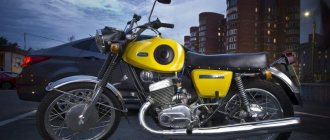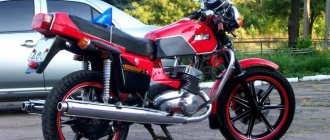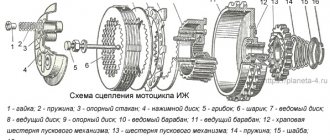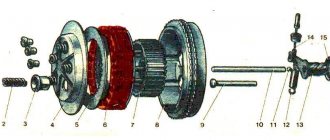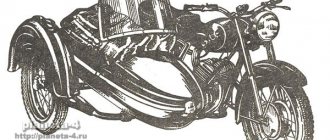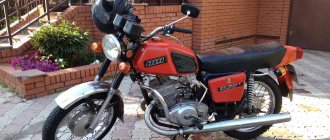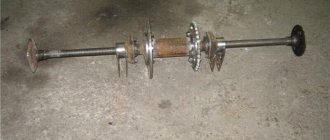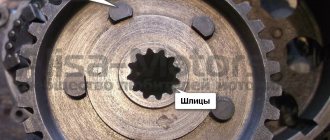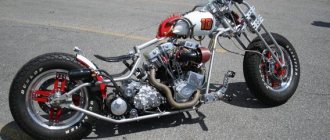Izh Jupiter is a popular Soviet motorcycle that is great for riding on almost any road surface.. Among the obvious advantages of the model are compact dimensions, good maneuverability and relatively low fuel consumption.
If you pay attention to modern bikes of this type, then it’s also worth adding good speed and dynamics.
Appearance
When discussing the aesthetic appeal of the vehicle, it is worth noting that there is nothing particularly special about the Jupiter 5 model . Everything looks quite simple and strict. Nevertheless, for many such classics are the standard of beauty and style. There were no obvious changes here when compared with the 4th model. Notable innovations include only different cylinder fins and new flange mountings for the exhaust pipes.
Otherwise, the Jupiter motorcycle remains the same timeless classic.
Video about the IZH Jupiter 5 motorcycle:
Price
Today, a motorcycle of this model is not so difficult to find; in Soviet times it was bought in large quantities, so today you just need to find out how much the Izh Jupiter 5 costs. Of course, the price depends on the condition, because over such a long period many parts could become faulty.
Even during the release of the Izh Jupiter 5 , its price was quite high - 1,050 rubles. But this did not stop buyers; they wanted a comfortable and fast motorcycle, which was the best then. But still, compared to other motorcycles, this model had a relatively low price. For example, then new Ural motorcycles had a price of 1,870 rubles.
If you want to buy a legend of the USSR today, be prepared to pay 55,000 rubles for a new motorcycle. Yes, they are still being reliably produced. If this price is too high for you, buy a used model - its price ranges from 5 to 40 thousand rubles.
If you want to learn more about IZ motorcycles, and this model in particular, download the instruction manual - IZ Manual.
Modifications
The Izh Jupiter motorcycle came to the market in three modifications:
- standard. It came without a side trailer, at the same time, there were mounts for the stroller;
- tourist. The vehicle was equipped with a sidecar, as well as an additional spare tire with increased lugs. Marked as 5T;
- lux (5L). Without side trailer and attachments to it. On the other hand, there was a compact fairing, a pair of knee roll bars, and a towed rack.
Dimensions and weight of the model
When discussing the characteristics of Izh Jupiter 5, one cannot miss parameters related to size and weight. The most basic of them looked like this:
- ground clearance height - 13.5 cm;
- wheelbase – 145 cm;
- length – 217 cm;
- width – 81 cm;
- height – 117 cm.
You may also be interested in: Modern Ural motorcycles and spare parts for them
If you are interested in how much Izh Jupiter 5 weighs, then its mass reached 160 kilograms. This was quite enough to make the vehicle both stable and maneuverable. In models with a side trailer, the weight was 255 kg.
The vehicle could withstand a load of 170 kg; in the case of a stroller, this parameter increased to 255 kg. Moreover, such indicators are not maximum, but recommended. Thus, the motorcycle could easily transport fairly heavy loads, without the risk of accelerated wear or breakdown.
Let's talk about the characteristics
The main technical characteristics of Izh Jupiter-5 are indicated for both a single vehicle and a trailer.
| Description | Single option | With trailer on the side |
| Main indicators of the Izh Jupiter-5 motorcycle in meters without mirrors length/width/height | 2,17/0,81/1,17 | 2,2/1,7/1,3 |
| Net weight, kg | 160 | 255 |
| Maximum available for load in kg | 170 | 255 |
| Speed limit km/h | 125 | 95 |
| Engine characteristics of Izh Jupiter-5 | A pair of cylinders, two strokes, capacity 347.6 cm3, power 24-25 horsepower | |
| Ignition mechanism | Battery | |
| Fuel type | Gasoline, octane number from 76; A-76, AI-93 | |
| Air purifier type | Contact oil | |
| Cooling system | Liquid | |
| Clutch type | Discs in oil bath | |
| checkpoint | In four steps; | |
| Gear shift mechanism | Foot-operated semi-automatic and manual release | |
| Frame type | Single, welded | |
| Wheels (standard/front/spare) 3.50x18/3.25x19/3.75x18 (inches) | ||
| Brake system | Mechanical drive | |
| Rear brake | Drum single-cam on traction; | 1-cam drum |
| Front brake | Single piston disc with hydraulics or cable two-cam drum with mechanics | 1-cam drum |
Izh Jupiter 5: technical specifications
The model demonstrates quite good parameters. The main technical characteristics of the Izh Jupiter 5 motorcycle look like this:
- power unit power – 25 horsepower;
- engine volume – 347.6 cm3;
- ignition type – battery.
This vehicle used a two-cylinder two-stroke engine with built-in air-water cooling. The transitional model Izh Jupiter 5 could reach speeds of up to 125 kilometers per hour. In the case of the model with a sidecar, the dynamics and maximum acceleration were somewhat reduced, so that the motorbike could only reach 95 km/h. At the same time, this bike is not designed for track racing, so, in principle, nothing more is needed.
I’ve been driving a new engine for half a year now and couldn’t write a post about it. So.
In the previous post, I described almost all the work, all the alterations and problems that got in my way. Naturally there were many mistakes, both technical and personal. In general, that’s why it was a test motor. Now I’ll tell you all the modifications that I made to my motorcycle for 2016. 1. I bought new USSR crankcases with live bearing seats. 2. For a long time I was looking for original Yu5 cheeks for a finger ngsh 21mm. I finally found and sent the connecting rods on the seperators to the master for repressing near Minsk. + I sent the flywheel to lighten it (1.8 kg) This is what happened.
4. Erics seals
5. Box USSR Jupiter 3.
6. Wide basket with long springs and Atlant discs.
It looks like the motor itself is assembled, but the most interesting thing remains. “Top” I have long dreamed of a drill and finally bought this miracle. Of course, not a corner one and not even an original Dremel, but as practice has shown, about 10 pairs of pots were sawed down.
I sawed it to my friends and took up my cylinders.
I tried to adhere to Grigoriev’s theory, but it turned out that I went a little too far and the release phase reached 180. In general, but I understood what it was like)
After washing it down, I gave the cylinders for boring and honing. As it turned out from the nominal value, I had to sharpen it before the 2nd repair (Almot piston).
Regarding the pistons: 1. Windows were cut out for a constant intake. (as I saw, I don’t say everything is in the previous post) 2. I turned out the refrigerators. 3.Sharpened the bottom to fully open the windows. (a controversial option, many people will say this is nonsense, I tried it and liked it, in general it definitely didn’t get any worse) 4. I made a “panacea for the wedge”
5. Aligned the piston with the purge. 6. Adjusted the weight of the pistons. By the way, the running-in was tough. Hard running-in. Up to 300 km, I used the engine carefully until 3500-4000, after which I squeezed out everything I could until 8000. There were no sticking conditions. I certainly don't impose my thoughts. Everyone chooses for themselves, but I am another confirmation that live running is not nonsense and the engine life does not suffer. While the cylinders were being bored, I started doing the wiring. Even though the charge on my original BPV was good, I wanted to get rid of the original brushes. (the brushes froze at high speeds) I did it as follows.
Horseshoe and RR from vases. Charging is stable at speeds from 1000rpm to 8000rpm. I did everything according to this scheme.
Thanks to Yuri Zvarov for help in connecting. Vadim Hellsing for the pp and a couple of tips.
I decided to completely replace the front end with one from IZh PS.
The pendulum is in excellent condition, so I did not dare to disassemble it and replace the bushings with bearings. I only replaced the shock absorbers with Chinese gas-oil ones. Of course, I wanted to look for the Showa type from Japanese motorcycles, but the price is steep.
(don’t blame me for the background; I took a photo in the dorm) By the way, as further rides showed, the shock absorbers are very good for the money. The potholes are swallowed along the road, the rear does not throw or bounce. With the passenger, everything worked just fine, didn’t knock and worked great, overall I’m happy.
In addition to everything, I also installed an electronic speedometer, which won in the drawing, a temperature sensor and emergency lights.
+ I wanted to stick a fuse which, as it turns out, is a very useful thing and has a positive effect on the service life of the battery
Video: Dashboard A parcel with spare parts arrived)
I really liked the USSR carburetor repair kits with unusual flaps (alloy like metal). A little humor, here’s a comparison with the Honda Dio piston)
I bought my favorite NGK spark plugs, since the carburetors will need to be adjusted again, so preferably new spark plugs.
I put my heads under 95 gasoline.
I burned and painted the resonators again. Photos from repairs and setup.
Replaced the petals and ground the valve again. (on the new petals the motor began to work easier and I really liked it)
I adjusted everything again and set it up and it turned out that after washing it down the GTZ 240 was already small and something more was needed. As I later learned, GTZ from Solex carburetors are suitable for Pekar both with threads and other characteristics. I bought myself a bunch of GTZ in increments of 5 units and started changing and testing. It turned out that both cylinders needed 290gtzh. Although I thought that my appetite would increase, this did not bother me since the motorcycle is for sensations and not for economy. And then, when I checked the consumption, I was very surprised in the good sense of the word.
It seems I did everything I wanted. Below is a video and photos from the rides. Video 19 star rpm 6400 (not maximum) pipes are original.
The first rides were on February 20, the weather was good and we decided to go to the sea with friends.
That's probably all. I did almost everything I wanted both on the engine and on the entire motorcycle. The plans also include Japanese piston, good resonators and new brakes. I want to say thanks to people like Anatoly Lukyanenko, Yuri Zvarov, Sergey Sirko, Drobot Vovchik, Vadim Hellsing and others who helped me with the construction and advice.Fuel consumption Izh Jupiter 5
The Jupiter motorcycle demonstrates quite good performance in terms of fuel consumption.
The model with a side trailer required about 7.1 l/100 km, without it - 5.9 l.
In principle, for Soviet vehicles the figure is not that high, but now a motorcycle can no longer be called economical.
Now about “Planet”
The popularity of the 5th “Jupiter” sought to shake a motorcycle from the same factory, only of a different series, no less famous and popular - “Planet”. Already the 5th variation of one of the most popular motorcycles in the USSR rolled off the assembly line in 1987.
And I must say, they were on par with “Jupiter”. The same maximum acceleration speed is 120 km/h, but these are not sportbikes, so it is quite acceptable. In terms of carrying capacity, it is worth noting that the “Planet” still lost to the “Jupiter” - 150 kg versus 170 kg, respectively, but such indicators were not critical, since both the first and the second were not designed for a serious load, and for everything else there was motorized stroller In general, both motorcycles won their audience, and not only gained wide popularity in the USSR itself, but also retained it in the post-Soviet space.
Features of tuning models
It is worth saying that the Jupiter 5 motorcycle lends itself perfectly to modernization, which is what domestic craftsmen use. If you want to improve the parameters of your two-wheeled horse, then, first of all, you should:
- replace ignition contacts on electronics;
- install a tachometer;
- add a leg on the side instead of mounting the power unit;
- install samples in the exhaust, which will help change the sound of the engine;
- add a couple of extra carburetors (it is worth noting that this will not only increase the power of the Izh Jupiter 5 motorcycle, but will also increase fuel consumption);
- update the turn signals and mirrors, remove the trunk. This will add additional attractiveness and charm to the model.
It will also be interesting: Kawasaki motorcycles - creations that need no introduction
First about “Jupiter”
This model was first released in 1985, already during the times of Perestroika and Gorbachev. In terms of its parameters - speed, load capacity and engine power, Jupiter was not a model with advanced characteristics at that time. Yes, the opportunity to cut across the highway at 120 km/h was very, very tempting, especially if a pretty girl was squealing joyfully in the back seat, but it was by no means impossible to say that it was something beyond the realm of possibility.
And the fact that the motorcycle could withstand no more than 170 kg of live weight at a time was also not particularly joyful, since, in fact, two adult men might not have fit there, so to speak. Of course, a motorcycle sidecar solved the problem, but this is an additional cost that no one is happy about. However, all this suggests that “Jupiter” was not the best in its class, but not that this model turned out to be bad. On the contrary, the build quality and a wide selection of parts in any specialized store made Jupiter-5 very, very popular among motorcycle enthusiasts.
A short summary
Looking at the photo of Izh Jupiter 5, you can feel nostalgic - after all, this is exactly the vehicle from childhood and adolescence that many of us drove along rural roads and small streets . At the same time, Izh Jupiter 6 is still alive today.
Perhaps the basic technical parameters here are not very high, but thanks to countless modifications and modernization, this Soviet motorcycle can compete on the road with more modern vehicles.
Video review of the Soviet motorcycle IZH Jupiter 5:
